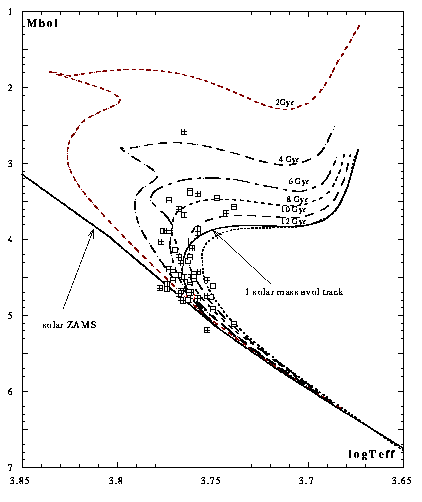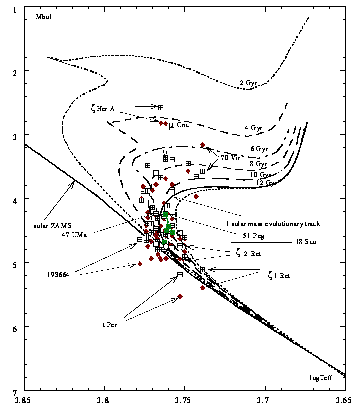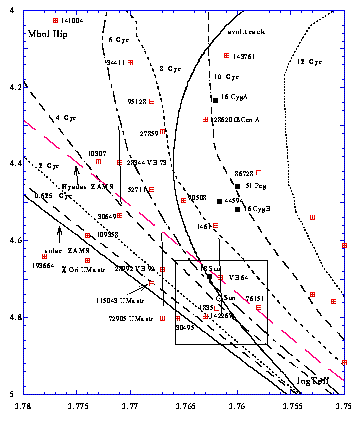
Last May during the "Hipparcos, Venice '97" conference we have shown (Cayrel de Strobel et al. 1997) that the accuracy of the Hipparcos parallaxes combined with a precise determination of their effective temperature, chemical composition, and spectroscopic gravity has allowed us to locate the Hyades dwarfs on their appropriate ZAMS and consequently to determine their He abundance, Y=0.26 ± 0.02 (in mass).
How does Hipparcos change our understanding of the parameters and evolutionary status of our sample of 99 solar analogs discussed in Cayrel de Strobel (1996)? First, it reduces our sample size to only 52 objects, probably because the stars we have included in our initial list of solar analog candidates were unknown binary stars, or not apt to be observed by Hipparcos, and then because in this new list of solar analogs the most metal poor stars in Table 1 and Figure 1 of Cayrel de Strobel (1996) have been omitted. The basic data adopted for these 52 solar analogs are given in Table 1, which lists in the first three columns the HD number, common name, and the number used in the Hipparcos and Tycho Catalogues (ESA, June 1997, SP-1200), followed by the photometric parameters V and B-V, the spectral type, and the spectroscopic determinations of metallicity, [Fe/H], and temperature, as log Teff. The last 3 columns give the Hipparcos parallax, in milliarcseconds, and the determinations of bolometric magnitudes, the first from the ground based parallaxes, and the second those based on the Hipparcos parallaxes.
We show in Figure 2 the observational (log Teff, Mbol) diagram for these 52 stars using Hipparcos parallaxes as the basis for Mbol determinations. The theoretical tracks are from Lebreton et al (1997), as in Figure 1. These models show that the present Sun, with Mbol = 4.75, has moved by Delta Mbol =-0.42 mag above its initial position and by Delta log Teff = +0.0123 (corresponding to Delta Teff =166K) in effective temperature.

FIGURE 2:Observational (log Teff, Mbol) diagram of 52 solar analogs having Hipparcos (Hip) parallaxes as the basis of their Mbol determination with an overplot of the same theoretical diagram as in Figure 1. The sample size is reduced to only 52 objects because some of the stars included in the Cayrel de Strobel (1996) list were unknown binary stars and also because the most metal poor stars in the 1996 list have been omitted here. Please note that the underluminosity of certain stars has disappeared in this diagram.}
In Figure 1, we noted that a fair number of analogs are more evolved and older than the Sun. The evolutionary status and the old age of these objects is confirmed by Hipparcos. In ``Hipparcos, Venice '97" we have heard that for many stars, (but not for all), Hip parallaxes tend to make them more luminous. This is also seen in our sample of 52 stars: their (log Teff, Mbol) diagram (Figure 2) has lost, except for two stars, the underluminous objects seen on the preceding H-R diagram. One can argue that, precisely, these underluminous stars have not been observed by Hipparcos, or rejected by us because of their high metal deficiency, but the comparison shown in Figure 3 between the same 52 stars having both ground based parallaxes (filled diamonds) and Hip parallaxes (crossed or filled squares), as the basis of their Mbol determinations, shows that some stars of the sample with ground-based parallaxes lie below the main sequence. Clearly seen in Figure 3 is the tendency for the use of Hip parallaxes to brighten the Mbol of stars. Note that in Figure 3 the abscissae have been kept strictly the same in the sample of 52 stars possessing either Mbol's from ground based parallaxes, or Mbol's from Hip parallaxes. Figure 2 shows that relatively few Hipparcos analogs are main-sequence stars.

FIGURE 3:Comparison between observational (log Teff, Mbol) diagrams of 52 solar analogs using different sources for bolometric magnitudes, with an overplot of the same theoretical diagram as in Figure 1. Filled diamonds represent absolute bolometric magnitudes, Mbols, computed with ground-based parallaxes, and crossed and filled squares represent Mbols computed with Hip-parallaxes. Filled squares denote some of the past 'best' solar analogs. Here, clearly it is seen that the Hip Mbols of many objects brighten their positions in the H-R diagram with respect to the ground-based positions of the same stars.
A few notable objects can be seen in Figure 3, such as the three best known stars which are thought to have planetary companions: 51 Peg (Mayor and Queloz 1995), 70 Vir (Marcy and Butler 1996), and 47 UMa (Marcy and Butler 1996). The absolute bolometric magnitude of the star HD 193664 from its ground-based parallax is 0.49 mag. fainter than that from its Hip parallax. Similarly, that of iota Per is 0.47 mag fainter. On the contrary, good examples of stars becoming fainter as a result of using Hipparcos Mbols are mu Cnc and the planet star 70 Vir. The values of the Hip Mbol's of the well known components of the binary zeta1 and zeta2 Ret, together with the values of Teff and [Fe/H] from a careful detailed analysis by Del Peloso (1997), has permitted us to attribute to this couple of disk stars a very old age: both are lying nicely on the 12 Gyr isochrone.
What has happened to our best candidates for `solar twins'? Figs. 4 and 5 show an expansion of the region in the H-R diagram around the Sun. Figure 5 shows only those stars in Figure 4 with approximately solar metallicity, i.e. those with a metal abundance defined as: [Fe/H] = 0.0 ± 0.10. Note that in these two figures the total span in abscissa is only Delta log Teff = 0.03, from Teff = 5625 to Teff = 6025 K, and in ordinates only 1 mag. The straight full line is the ZAMS for the chemical composition of the Sun. The straight dashed line is the ZAMS for the chemical composition of the Hyades. The full curved line is the evolutionary track of the Sun. VB 64, a Hyades effective temperature solar analog, is significantly more metal-rich than the Sun, and its position actually fits very nicely on the ZAMS at its appropriate metallicity. Other Hyades stars, VB 92 and VB 73, are shown in Figure 4 with vertical lines indicating the size of 1-sigma error bars. Clearly the positions of these stars are also consistent with the Hyades ZAMS. The star 18 Sco, (probably the best solar analog), falls on the 1 solar mass evolutionary track and on the isochrone of 6 Gyr. Abrupt changes of slope of the very magnified isochrones reflect grid points of the models.

FIGURE 4:Zoom of the region in the previous H-R diagram (Figure 3) around the Sun. The straight full line is the ZAMS for the chemical composition of the Sun. The straight dashed line is the ZAMS for the chemical composition of the Hyades. The full curved line is the evolutionary track of the Sun. VB 64, a Hyades star, is significantly more metal-rich than the Sun, and its position actually fits very nicely on the ZAMS at the appropriate metallicity. The star 18 Sco, (probably the best solar analog), falls on the 1 solar mass evolutionary track and on the isochrone of 6 Gyr. Abrupt changes of slope in the isochrones reflect grid points of the models.

FIGURE 5:The same as Figure 4, but this (log Teff, Mbol) diagram contains only solar metal normal stars, having their metal abundance defined as: Delta [Fe/H] = 0.00 ± 0.10. Note that in Figures 4 and 5 the total span in abscissa is only: Delta log Teff = 0.03, from Teff = 5625 to Teff = 6025 K, and in ordinates, 1 mag. Here, and in Figure 4, the box drawn around the Sun's position defines the region within 60 K and 0.1 mag of the Sun's effective temperature and bolometric magnitude. These are the mean error bars adopted for the stars with Hipparcos parallaxes.
The box drawn around the Sun's position in Figs. 4 and 5 defines the region within 60 K and 0.1 mag of the Sun's effective temperature and bolometric magnitude. By the way, these are also the mean error bars we have adopted for the stars with Hipparcos parallaxes. Very few stars now sit within this region of solar 'twinness' in Figure 4 and even less, in Figure 5. Notable in Figure 4 are : 18 Sco, VB 64, and HR 1835. Of these, we have heard a great deal about 18 Sco at this conference. HR 1835, we have heard, is much more chromospherically active, hence younger, than the Sun and 18 Sco is now our closest twin. The new parallaxes reinforce the conclusions (Friel et al. 1993) that 16 Cyg A and B are both more evolved and older than the Sun, at 10 Gyr. Other solar analogs that are thought to have planetary companions, 51 Peg, 70 Vir and 47 UMa, are also more evolved and appreciably older than the Sun. Hardorp's (1978) best analog, HD 44594, is not contained in the H-R diagram of Figure 5 because it is appreciably more metal-rich than the Sun. The box drawn around the Sun in Figure 5 contains three stars: 18 Sco (Porto de Mello: in this workshop), HD76151 (Cayrel de Strobel and Bentolila 1989) and HD 30495 (Pasquini et al. 1994). Their detailed analyses have produced trustworthy atmospheric parameters: Teff, log g, and [Fe/H] and with their new Hip parallaxes these three stars certainly deserve to surround the Sun.